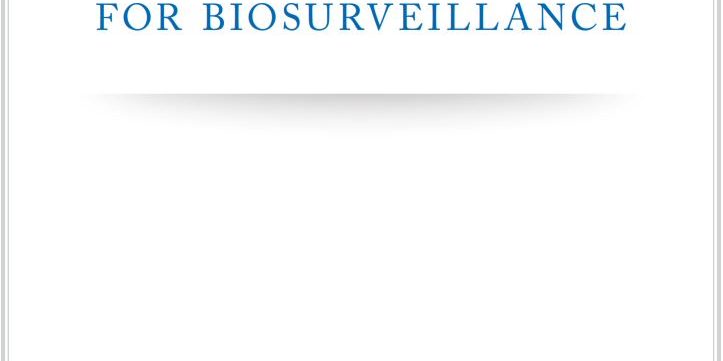Biosurveillance: Threat, purposes and requirements
Since the 1970s, newly emerging diseases have been identified at a rate of one or more per year. Further, terrorism experts warn that both terrorists and nations seek to obtain biological weapons. [1,2] The National Strategy for Countering Biological Threats notes: (i) risk is evolving in unpredictable ways; (ii) advances in enabling technologies will continue to be globally available and (iii) the ability to exploit such advances will become increasingly accessible to those with ill intent as the technical expertise and monetary cost barriers decline. [3] Finally, the nation’s food and agriculture systems face threats from natural and intentional origin. These threats could have devastating consequences in terms of both health and economic loss. [2,4]
Biosurveillance is performed for two major reasons: to reduce the time it takes to recognize and characterize biological events with potentially catastrophic consequences and to provide situational awareness (i.e., information that signals an event might be occurring, what those signals mean, and how events will likely unfold in the near future). [2] It enables better decision making by gathering, integrating, interpreting and communicating essential information to achieve early detection and warning. [5] Biosurveillance spans boundaries between surveillance for public health threats, protection and monitoring and bioterrorism. Accordingly, traditional demarcations are increasingly fading among public health, animal health, ecological health and biosecurity and bioterrorism defense surveillance capabilities. [6]
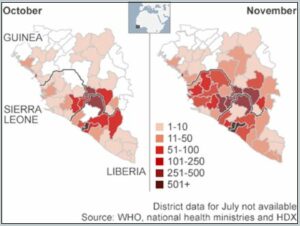
Figure 1. Biosurveillance showing an increase in Ebola cases reported in West African areas from October to November 2014. (Released)
The backbone of biosurveillance is comprised of traditional disease surveillance systems, which help professionals recognize unusual disease signals and analyze their meaning. These systems generally have inherent limitations that affect the speed at which results can be determined, communicated and acted upon. Numerous federal, state, local and private sector entities with responsibility for monitoring plant, animal and human health, food and the environment have roles to play both in supporting traditional surveillance activities and in designing systems to focus specifically on enhancing detection and situational awareness. Because of the array of activities and entities associated with effective biosurveillance, ongoing interagency, international, and intergovernmental collaboration is crucial. [2]
The national biosurveillance strategy
The National Strategy for Biosurveillance is based on four core functions: [5]
• Scan and discern the environment: Rapidly evaluate information to speed incident detection, confirm conditions and identify the emergence of new patterns or trends while assessing their significance.
• Identify and integrate essential information: Derive, integrate and share useful and essential information and speed up incident awareness. Detect the earliest signs of potential health threats, focus biosurveillance activities on the characterization and validation of the identified threat, track the threat and provide ongoing awareness.
• Inform and alert decision makers: Rapidly inform decision makers of potential incidents of national significance and provide early warning and updates throughout an emerging incident.
• Forecast/advise of potential impacts: Inspire new thinking and methodologies to forecast. Forecast the probable trajectory, duration and magnitude of the incident into the future, enabling rapid response to save lives and prevent negative economic consequences, even amidst great uncertainty and ambiguity.
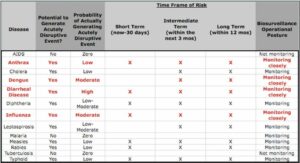
Figure 2. Example of biosurveillance operational posture in Haiti post-earthquake, relative to risk and timing of acute disruptive events. (Released)
The strategy identifies four enablers for strengthening biosurveillance:
• Integrate capabilities: Establish regional information sharing arrangements combining human, animal and plant health trends. Transcend regular boundaries and traditional organizational lines. Consider social media as a force multiplier that can empower individuals and communities to provide early warning and global situational awareness.
• Build capacity: Use point-of-care and multipathogen diagnostics, law enforcement, intelligence and other information collection/sharing activities. For example, the Global Biosurveillance Technology Initiative Exemplar laboratory located at Edgewood Chemical Biological Center will serve as a resource for many stakeholders as a test bed for component, reagent and bioinformatics upgrades. [7]
• Foster innovation: Identify capabilities to facilitate biosurveillance activities. Create distributed networks and empower individuals to enhance the value of biosurveillance information. Encourage new thinking and methodologies to forecast likely incidents, food-borne illness, environmental disasters and outbreak trajectories in the absence of definitive data.
• Strengthen partnerships: Pursue biosurveillance activities that promote the sharing of information between/among federal, state, local and other national enterprise participants. For example, the National Association of City and Community Health Organizations supports local biosurveillance efforts by sharing critical information regarding systems, practices and resources that will enhance the local health department’s ability to detect and prevent the spread of disease in an effective and timely manner. [8] Successful partnering was demonstrated in the Early Alerting and Reporting project that interfaced a biosurveillance portal and an international network of institutional analysts working with a common standard operating procedure and risk assessment tools to constantly screen and assess public information on the web for events that could suggest an intentional release of biological agents. [9]
The National Biosurveillance Integration Center
The National Biosurveillance Integration Center, chartered by the recommendations of the 9/11 Commission Act of 2007 and housed in the Department of Homeland Security, responds to the requirements of Homeland Security Presidential Directives 9, 10 and 21. [2] The center implements the core functions discussed above and oversees the development and operation of the National Biosurveillance Integration System. The system promotes collaboration among federal partners and state stakeholders for the collection, analysis and sharing of human, animal, plant, food and environmental biosurveillance information with the center. [10,11] For example, BioWatch is a federally-managed, locally-operated, nationwide biosurveillance system designed to detect the intentional release of aerosolized biological agents and act as an
interface for state and local public health and responder communities to jointly respond to a bioterrorism event. The BioWatch system collects air samples in more than 30 cities, and a network of local, state and federal laboratories analyze samples on a daily basis to provide warnings within 12 to 36 hours of an agent’s release for possible biological attacks. BioWatch has operated continuously for more than 10 years. The program began exploring technologies to reduce false positives and detection and response times in a cost-effective manner. This would involve an autonomous detector, a “lab-in-a-box,” where the sampling and analysis processes would take place within the device, generating results as soon as four to six hours after the release of a biological agent. However, it was concluded the system would not meet objectives at a reasonable cost, and the acquisition was cancelled. [12]
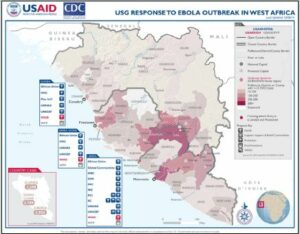
Figure 3. Biosurveillance provides a focus for U.S. aid during the Ebola outbreak in West Africa. (Released)
The DoD Biosurveillance Enterprise
The Department of Defense Biosurveillance Enterprise undertakes a variety of biosurveillance activities in the United States and internationally. It also supports collaborative surveillance with foreign governments in countries and regions of interest for the countries’ own situational awareness and reporting. DoD, the U.S. government and international policy makers and responders are the consumers of information produced by the DoD Biosurveillance Enterprise. [13, 14]
Since emerging infectious diseases became part of the chemical and biological defense mission, the Defense Threat Reduction Agency has advanced its biosurveillance capabilities. [15] On June 13, 2013, the deputy secretary of defense issued Interim Guidance for Implementing the National Strategy for Biosurveillance. [16] It provides guidance “to improve the integration, synchronization, and coordination of biosurveillance-related activities in support of national and DoD priorities.” This involves collecting, integrating and analyzing data and reporting information produced by DoD biosurveillance-related activities supporting requirements identified by military departments and combatant commands. The biosurveillance-related data is then available for integration at the tactical, operational and strategic levels.
DoD has several programs involving global biosurveillance, including the Global Emerging Infections Surveillance and Response System, a
division of the Armed Forces Health Surveillance Center. [17] GEIS embraces 33 partners, including military laboratories, academic institutions and non-governmental organizations around the world, that support service members and population-based surveillance and capacity building in 62 countries. [18] AFHSC-GEIS goals are to: (i) conduct surveillance and outbreak response activities, (ii) improve the capacity of partner countries to perform disease surveillance, (iii) support research initiatives that will result in new capabilities in support of force health protection and (iv) assess and communicate through its worldwide network. [19] AFHSC is collaborating with the Johns Hopkins University Applied Physics Laboratory to create the Suite for Automated Global Electronic Biosurveillance, a collection of modular, flexible, open source software tools for electronic disease surveillance. [20] Also, a team of scientists from the Applied Physics Laboratory has developed a novel capability to predict the outbreak of infectious diseases, known as PRISM, Predicting Infectious Disease Scalable Model, which extracts relationships among clinical, meteorological, climatic and sociopolitical data. Outputs from the model predict disease incidence in regions of interest, enhancing awareness and providing critical lead times for preemptive public health actions. [21]
A recent RAND report examined biosurveillance efforts from the viewpoint of a logic model that flows from inputs (enabling functions and funding) to processes (biosurveillance systems and assets), outputs (reports and alerts), outcomes (desired outcomes from biosurveillance) and impacts (strategic missions served). [13] DoD’s biosurveillance efforts support several outcomes: early warning of threats and early detection of events; situational awareness; decision making at all levels, including acute response, policy and research and development; and forecasting impacts.
The inter-agency Biosurveillance Science and Technology Working Group
The inter-agency Biosurveillance Science and Technology Working Group develops national biosurveillance research and development priorities to enable the core functions of the National Strategy for Biosurveillance. It also addresses deficiencies noted in a report of the National Biosurveillance Advisory Subcommittee. [22] In four separate but interrelated areas, specific capability needs were identified as follows: [23]
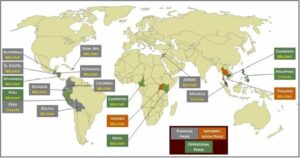
Figure 4: Promotion of emerging infectious disease outbreak surveillance and response capacity. In consultation and coordination with the Johns Hopkins University Applied Physics Laboratory, electronic disease surveillance systems have been piloted and fully implemented by many host nation civilian and military health authorities in the past three years.
(Released)
Aberration detection
• Surveillance methodologies that integrate traditional monitoring (pathogen, environmental and health) with background data (meteorological and population dynamics) that may influence risk;
• Ability to detect early warning signs of changes occurring at different and changing spatial and temporal scales; and
• Advancements in data sharing and integration and communication technologies including assessment methods and education and training to meet anticipated needs for biosurveillance professionals.
Risk anticipation
• Understanding the antecedent conditions at appropriate spatial and temporal scales; and
• Ability to forecast the dynamics of novel disease emergence or exploitation of biological agents by adversaries.
Threat identification and characterization
• Improving the sensitivity, specificity and portability of multiplexed technologies capable of identifying, with confidence, known and unknown threats in complex samples;
• Improved sample collection, preservation, transport, preparation technologies and protocols, standards for testing, evaluation of detection tools and validated testing and evaluation protocols;
• Improved diagnostic technologies and access to signatures, reagents, strains, sequence data, informatics and computational capabilities; and
• Improved surveillance techniques, data sharing and interoperability for plants, animals and food.
Information sharing, integration and analysis
• Aggregate analyzed health data from different health sources, syndromic surveillance systems and sectors to detect aberrations/discover spatial and temporal disease trends;
• Determine what data/information sources are relevant to biosurveillance;
• Sustained and appropriate multilateral information sharing.
• Integration of all existing and emerging biosurveillance efforts and cross-domain information sources into a coherent biosurveillance enterprise; and
• Standardized methods for determining the uncertainty in biosurveillance data and clearly communicating the limits of the data and analytical techniques. [23]
The integrated biosurveillance enterprise called for in the strategy will require collaboration and coordination across federal organizations, academia, industry and the international community. An example of this is the support the DoD Rapid Reaction Technology Office provides to DHS and Department of Health and Human Services by looking for emerging technologies to increase the nation’s preparedness against chemical, biological and agricultural threats in several specific areas: [24]
• Real time, indoor and outdoor environmental sensing: Chemical and biological threat detection and characterization; wearable and handheld sensors; trigger sensors.
• Data analytics: Predictive modeling in behavioral responses; indirect detection of chemical/biological events; decision support and planning; social media monitoring; real-time collaboration; unstructured data capture; structured data visualization.
• Internet of things: Personnel tagging, tracking and locating; wearable personal sensors; ad hoc networking.
• Information technology and communications: Personally identifiable information protection; public alerting and warning; integrated and interoperable communications; virtual network management, modeling and simulation.
Biosurveillance exercises
Large-scale biosurveillance exercises are in progress or have been completed. Typically, these involve inter-agency collaboration or cooperation and some involve international partners. For example, DoD and South Korea ran the Able Response Exercise in May 2011 and May 2012. “This is a whole-of-government to whole-of-government tabletop exercise focused on a biological incident, not during a conventional war but some type of a covert release that could have a major impact on the civilian population … but also on
our 28,000 forces deployed on the peninsula.” [25]
The Joint USFK Portal and Integrated Threat Recognition (JUPITR) program uses new instrumentation that increases the speed and ease of biosurveillance equipment for the United States Forces Korea. [26] It comes at a lower cost with less training/burden to the soldier but higher performance results.
JUPITR combines advanced communications with cutting-edge detection capabilities for rapid and efficient biosurveillance. The program is comprised of four legs: (i) an information portal, similar to a health surveillance web management tool, housing a library of identified biological substances that authorized personnel can access; (ii) Edgewood Chemical Biological Center researchers going to Korea to improve USFK laboratory capabilities; (iii) testing biological detectors and sending the best one to Korea and (iv) Integrated Base Defense: a large multifunctional, all seeing sensor that can rapidly design a defensive perimeter.

Figure 5. The Joint USFK Portal and Integrated Threat Recognition will provide unique biological detection capabilities and stronger biosurveillance capabilities. (Released)
JUPITR will fuse the capability of the networked suite of force protection sensors (radars, cameras, acoustic sensors, met sensors, etc.) with proven chemical/biological standoff and point sensors to demonstrate early warning. [27] The Distance Detection Devices, or D3 program, are a part of the JUPITR Advanced Technology Demonstration. The goal is to provide the most effective handheld biological detectors needed for a given mission. The D3 component is part of a multi-year effort designed to introduce warfighters to new, inexpensive, rapid and easy to operate chemical and biological detection technologies. It also integrates equipment to form a complete system that can automate and correlate data for improved detection insights. For example, Edgewood Chemical Biological Center scientists have designed and produced a more efficient and lower cost detector known as the TAC-BIO Gen II. This next generation tactical biological detector costs 80 percent less and is three times lighter than its predecessor. This new design captures the performance and cost advantages associated with plastic parts and uses an energy efficient power source. TAC-BIO Gen II exploits the fact that biological aerosols fluoresce and scatter light when exposed to ultraviolet light. These signals can be used to detect a threat by using a light-emitting diode developed under the Defense Advanced Research Projects Agency that replaces the larger and more costly ultraviolet lasers used previously. Further, lower costs enable multiple detectors to be set out, resulting in fewer false positives for biological detection, and ensuring that users can make accurate and fast decisions based on the detector results. [28,29]
Conclusions
Biosurveillance is key for detecting and limiting the consequences of a natural or man-made biological event, and its importance is recognized in national policy directives. Biosurveillance is intended to provide real-time information to decision makers regarding specifics on the type of biological material and location as a function of immediate and future time. Mounting a global biosurveillance capability is not a simple or inexpensive task. It involves a multitude of different technologies and capabilities that can rapidly detect targeted biological materials within defined temporal and spatial domains. This allows a clear understanding of the scope of the threat and its likely spread in the future. Data from many different sources and their fusion into a coherent useful present and future
picture, with defined risk, are keys to useful and predictive biosurveillance. Capability gaps are being recognized, and solutions are being worked on/implemented. This must be a collaborative effort involving international, national, state, local and other partners that form the biosurveillance enterprise to allow for early, rapid and appropriate responses, limiting consequences.
About the Author:
Timothy Karpetsky, Ph.D., has more than 40 years hands-on experience with CBRNE materials. He has conceived, developed and produced diverse equipment for the detect ion, identification of, and surveillance for such materials. Over this time, he has worked for and with the U.S. government and private companies, including heading a detection innovation skunk works. Originator of 14 published patents, he
has written many technical papers, including readiness assessments for manufacturing CBRNE defense equipment.
References
[1] Langston, S. M. (2013). The Threat of Domestic Bioterrorism: Fact or Fiction? (Master’s thesis).
[2] U.S. Government Accountability Office. (2010, June). Biosurveillance: Efforts to Develop a National Biosurveillance Capability Need a National Strategy and a Designated Leader. (Publication No. GAO-10-645).
[3] White House. (2009). National Strategy for Countering Biological Threats.
[4] Zeng, D., Chen, H., Castillo-Chavez, C., Lober, W.B., & Thurmond, M. (Eds.). (2010). Infectious Disease Informatics and Biosurveillance. Springer.
[5] White House. (2012). National Strategy for Biosurveillance.
[6] Margevicius, KJ., Generous, N., Taylor-McCabe, KJ., Brown, M., Daniel, WB., Castro, L., … Deshapande, A. (2014). Advancing a Framework to Enable Characterization and Evaluation of Data Streams Useful for Biosurveillance. PLoS ONE 9(1): e83730. doi:10.1371/journal.pone.0083730.
[7] Gervasoni, J. (2014, September 12). USAPHC lab capabilities enhanced to improve health protection.
[8] Biosurveillance. National Association of County & City Health Officials.
[9] Riccardo, F., Shigematsu, M., Chow, C., McKnight, C., Linge, J., Doherty, B., … Arthur, R. (2014, November). Interfacing a biosurveillance portal and an international network of institutional analysts to detect biological threats.
[10] National Biosurveillance Integration Center.
[11] Department of Homeland Security. (2012, November). National Biosurveillance Integration Center Strategic Plan [PDF file].
[12] Brinsfield, K. Written Testimony of OHA acting Assistant Secretary Dr. Kathy Brinsfield and S&T Under Secretary Dr. Reginald Brothers for a House Committee on Homeland Security, Subcommittee on Emergency Preparedness, Response, and Communications hearing titled “BioWatch: Lessons Learned and the Path Forward.”
[13] Moore, M., Fisher, G., & Stevens, C. (2013). Toward Integrated DoD Biosurveillance. [PDF file].
[14] Pellerin, C. (2013, May 28). U.S., EU Lead Global Nonproliferation, Biosurveillance Efforts.
[15] Pellerin, C. (2014, December 25). Defense Threat Reduction Agency Scans World for Biothreats.
[16] 2013 U.S. Deputy Secretary of Defense Memo (2013, June 13). Interim Guidance for Implementing the New National Strategy.
[17] Pellerin, C. (2011, October 27). Global Nature of Terrorism Drives Biosurveillance.
[18] Pellerin, C. (2013, June 5). Global Force’s Needs Shape DOD Biosurveillance.
[19] Lewis, S. H. (2014). Global Health Surveillance—Guest Editor’s Introduction. Johns Hopkins APL Technical Digest. 32 (4) pp.
648-51.
[20] Johns Hopkins Applied Physics Laboratory. SAGES.
[21] Johns Hopkins Applied Physics Laboratory. PRISM.
[22] Centers for Disease Control. (2011, April). Improving the Nation’s Ability to Detect and Respond to 21st Century Urgent Health Threats: Second Report of the National Biosurveillance Advisory Subcommittee. [PDF file].
[23] White House. (2013). National Biosurveillance Science and Technology Roadmap.
[24] Rapid Reaction Technology Office Biosurveillance Needs Statement. (2014).
[25] Pellerin, C. (2012). DOD Partners with Cities, Countries on Biosurveillance.
[26] JUPITR program takes shape on Korean Peninsula. (2014, March 12).
[27] Emanuel, P. (2013). Joint USFK Portal and Integrated Threat Recognition (JUPITR) ATD Plan Update. (Joint Program Executive Office for Chemical and Biological Defense).
[28] Army scientists improve early bio-threat detection. (2015, January 12).
[29] TACBIO Gen II; ECBC Pushes Convention of Biological Detection with Lightweight, Low-Cost Structure. (2015, January 13).


